Level 0 + OneClick
Implementation certification
Implementation requires passing a two-step certification. See the Certification process document for more information.
How it works?
To be able to pay with BLIK without a code, the User must be logged into the Shop's website. On Shop's side, the Level 0 OneClick payment process can be initiated from the browser version of the website, Shop's mobile app, or any other electronic channel. Along with the payment information with the BLIK code, the Shop sends the data needed to display an invitation to save the Shop in the banking app, where the User will confirm the payment. To save the Shop, the User must make a BLIK payment with the code on the merchant's website and accept the invitation to save the Shop in banking app. Once the User adds the Shop to the saved shop list in the banking app (accepts the invitation to save the Shop), the User will be able to pay at that Shop without entering the BLIK code.
The invitation to save a Shop is displayed in the User's banking app, where he/she confirms the payment. The User can manage saved Shops (adding/removing UID Aliases) only in the banking app.
An invitation to save the Shop
This is the set of data based on which the Alias for BLIK Payments without code is created. In the Level 0 OneClick implementation model, during the execution of a transaction with a BLIK code, the Shop attaches an invitation to save the Shop, which will be displayed in the users's banking app, where he confirms the payment.
A Shop that has implemented BLIK payments without a code in the Level 0 OneClick model (with Shop Memorization) sends an invitation to Shop Memorization along with a transaction performed with a BLIK code entered on its website or app. The invitation to save the Shop or browser should be sent with each initiation of payment with the BLIK code. When confirming payment in the banking app or immediately after the payment is confirmed, the bank presents the User with an invitation to save the Shop. If the User accepts the invitation, the Shop is saved in the banking app.
The Shop memorization invitation is sent by the Agent along with a transaction authorization request containing the 6-digit BLIK code and the data needed to send and display the invitation to save the Shop in the banking app. From a technical perspective, the Shop memorization instruction results in the registration of the UID Alias. The UID alias sent in the invitation is registered in the BLIK system by the bank and binds the User's account in the Shop system to a specific banking app.
The invitation must include:
During the confirmation of the transaction in the banking app or immediately after its confirmation, the User is presented with a proposal to add the Shop to the memorized list. If it is accepted, the bank registers in the BLIK system the received UID Alias binding it to the banking app from which the BLIK code used during the transaction (in the Shop's service) originated, and to which the invitation was sent. The BLIK system then sends a notification to the Agent about the registration of the Alias, which includes:
What does the process of saving the Shop look like?
After completing the order on the Shop's website, the User selects the BLIK payment method. He then goes to his banking app, where a BLIK code is generated. The User copies it and returns to the Shop's website, where he/she pastes (or types) it into the BLIK code entry field.
To ensure the smooth operation of BLIK payments, the BLIK code entry field must work in a certain way - when you start designing, read the requirements described in the Product Certification document.
After clicking the commit button (e.g. "Submit") on the Shop's website, the User should receive a message prompting him/her to go to the bank's mobile application where the BLIK code was generated and where the User must confirm the payment. After going (or being automatically transferred) to the bank's mobile application, the User is shown a confirmation screen with all the details of the payment. After confirming the payment with the PIN to the banking app, a message about the success of the payment is displayed along with an invitation to save the Shop. When the user accepts the invitation to save the Shop in the bank's mobile app, a success message is displayed. The Shop service also displays information about the successful payment.
Green screens - store
Purple screens- user's banking app
An example of the process of saving the Shop with an invitation displayed after a successful payment

Some banks allow you to accept the invitation to save the Shop on the payment confirmation screen. The user has the option to select "Approve and save" (payment confirmation and Shop saving), "Approve" (only payment confirmation) or "Cancel".
Example of the process of remembering a store with an invitation displayed on the confirmation screen

If the User does not accept the invitation to save the Shop in the banking app, in the service of this Shop, he can still pay only with the BLIK code.
BLIK payment without a code
When the alias is saved correctly, when you re-enter the Shop website and complete your order, two BLIK payment methods are available on the screen with the selection of payment methods. BLIK payment must be separated into two payment methods. The default selected and first on the list of methods is BLIK without code along with the obligatory banking app label displayed, and the next is BLIK with code (after saving Alias, the BLIK name changes to BLIK with code). After clicking the "Buy and pay" button, an instruction is displayed, prompting the user to go to the banking app and confirm the payment. The banking app displays the payment details one by one, and after the User confirms it - information about the success of the payment. The Shop website also displays information about the successful payment.
After the Shop is successfully memorized in the banking app, the banking app label (appLabel) in which the User has memorized the Shop, and in which the User will confirm BLIK payment without a code, must be displayed on the site of this Shop next to the BLIK method without a code. The banking app label must be presented regardless of the number of banking apps in which the User has memorized the Shop.
Example of BLIK payment process without code
ENG:
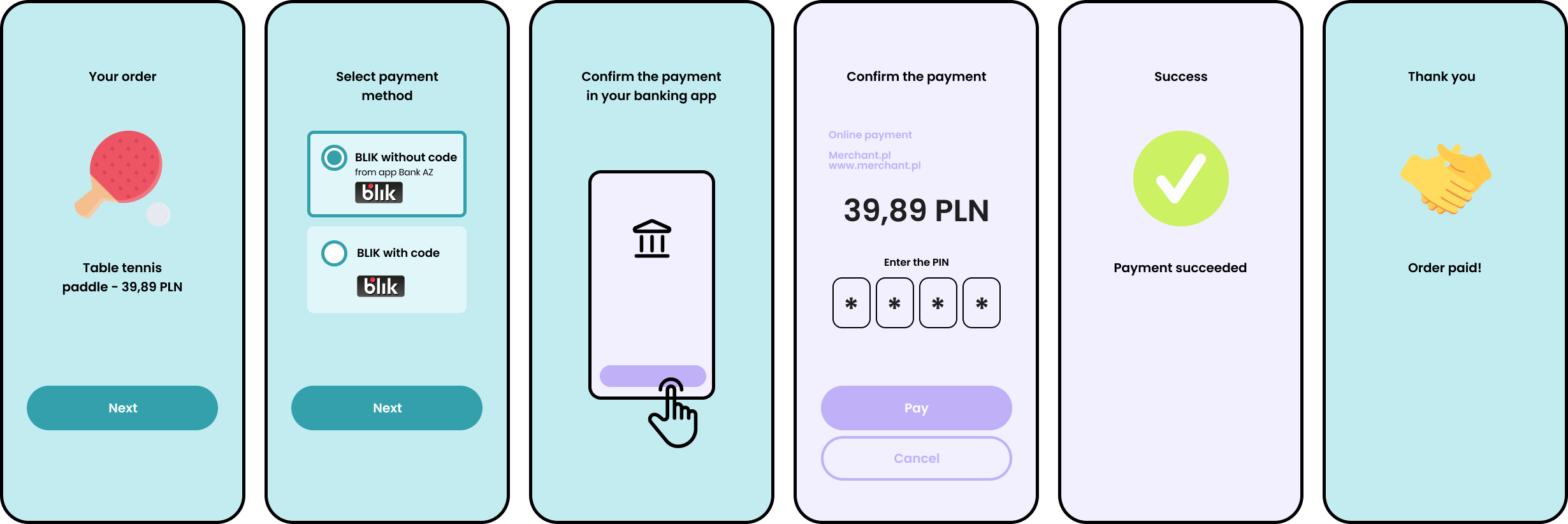
PL:
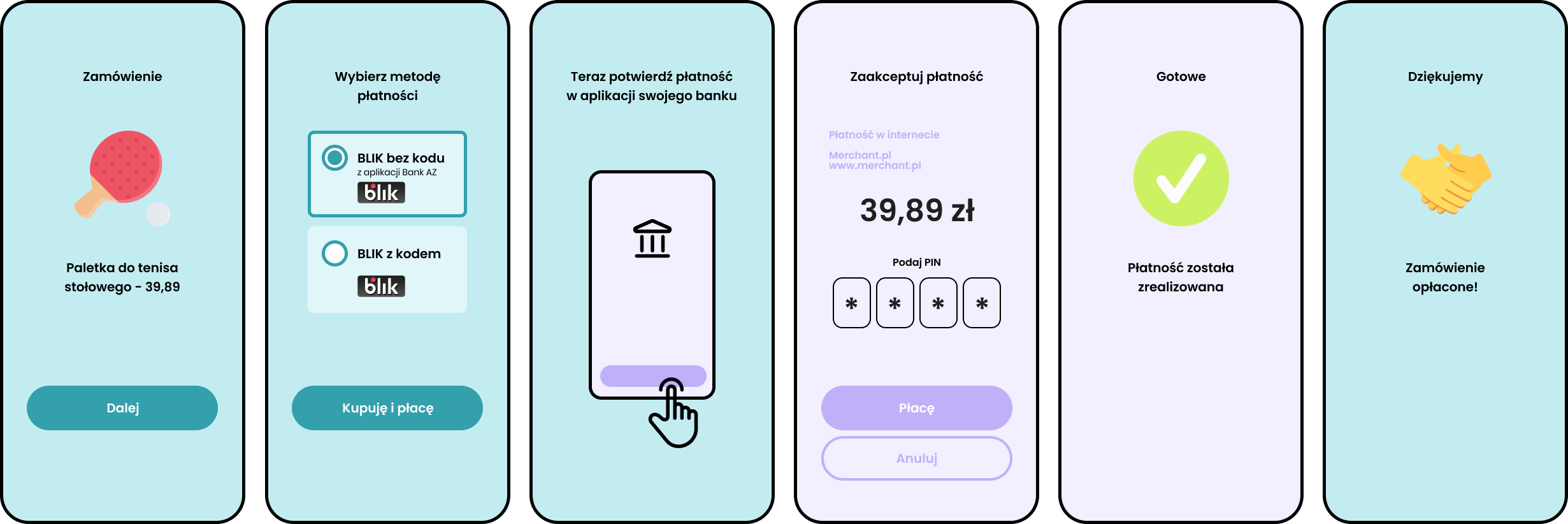
Despite saving the Shop in the banking app, the User still needs to be able to choose BLIK payment with a code.
When the User selects BLIK payment without code, an optional additional message "I want to pay with BLIK code" may be displayed. With the options to change the payment method to BLIK with a code and (even after initially selecting BLIK without a code) the additional option provided to pay with BLIK code, the User can save the Shop in another banking app or pay with a different banking app than the one in which the Shop was saved.
Example of BLIK payment process without code with additional button to pay with BLIK code
ENG:

PL:

Repeating Payments
To ensure high conversion of BLIK payments without a code, it is necessary to provide the possibility of repeating a failed payment - when proceeding with the design, read the requirements described in the BLIK with code - product checklist document.
First payment without BLIK code
At the first payment after saving the Shop, the Shop site can present information once:
"You no longer need to enter the BLIK code
You linked your [appLabel] account to this Shop during one of your previous payments. You can disable this linkage in the banking app at any time. We care about your security - purchases still need to be confirmed in the banking app."
Example of information display ENG: 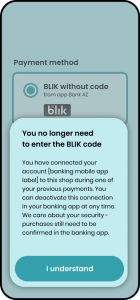
Example of information display PL:
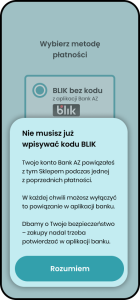
Banking app label (appLabel)
This is the name given by the bank (the publisher of the mobile application) to identify the mobile account where the User will confirm the payment. In some banks, Users can edit the banking app label. However, in most banks, the labels they assign are fixed values that the User cannot modify. The banking app label can consist of up to 20 characters. The label of the banking app is received by the Merchant in the notification of adding Alias.
Displaying the banking app label (appLabel) where the user has memorized the Shop is essential when implementing Level 0 OneClick.
It is important that the interface can support accepting values containing the maximum number of characters allowed. It is a mistake to abbreviate the displayed value by presenting it, for example, as "ban..." instead of "bank_XXXX", since labels are used to correctly identify mobile accounts. The user must be informed in which banking app the payment will be displayed for confirmation.
Occurring label templates
bank
Blik XXX
bank XXX
bank_XXXX
bank XX
bank_123
***789
bank - 123***789
Legend:
bank - the name of the bank or banking app
XX - first and last name initials
123***789 - masked phone number
XXXX - first and last name abbreviation
XXX first name, second name and last name abbreviation
Shop saved in multiple banks' mobile apps
An alias can be registered for more than one bank mobile application. In a situation where the User has memorized the Shop in several bank apps, the Shop site must display to the user a list of labels of mobile apps of banks to choose from during payment.
In what order should mobile app labels be displayed
If a new Alias was registered after the last BLIKIE payment with a code (the user saved the Shop in his/her banking app), the mobile app label associated with the key of the newly registered Alias should be presented first (the key should not be displayed), and the mobile app label that was used to make the previous payment without a code should be presented second.
If the last payment was without a code, the label of the banking app that was used to make that payment should be presented first, and the label of the app that was used before the User made the payment without a code using the app that is presented first should be presented second.
The label that is first in the list should be selected by default. An implementation in which only the first label is presented in the first view is acceptable, and the others are available when the "Change" option is selected.
Example of payment without BLIK code when Shop is saved in more than one banking app
ENG:
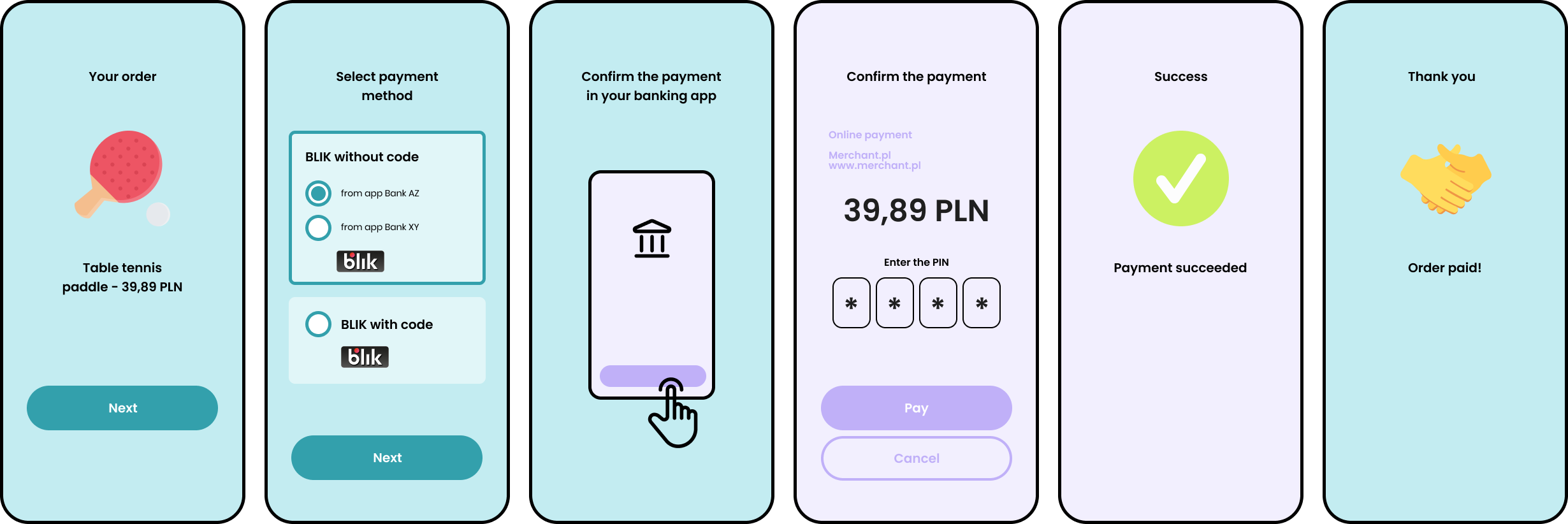
PL:
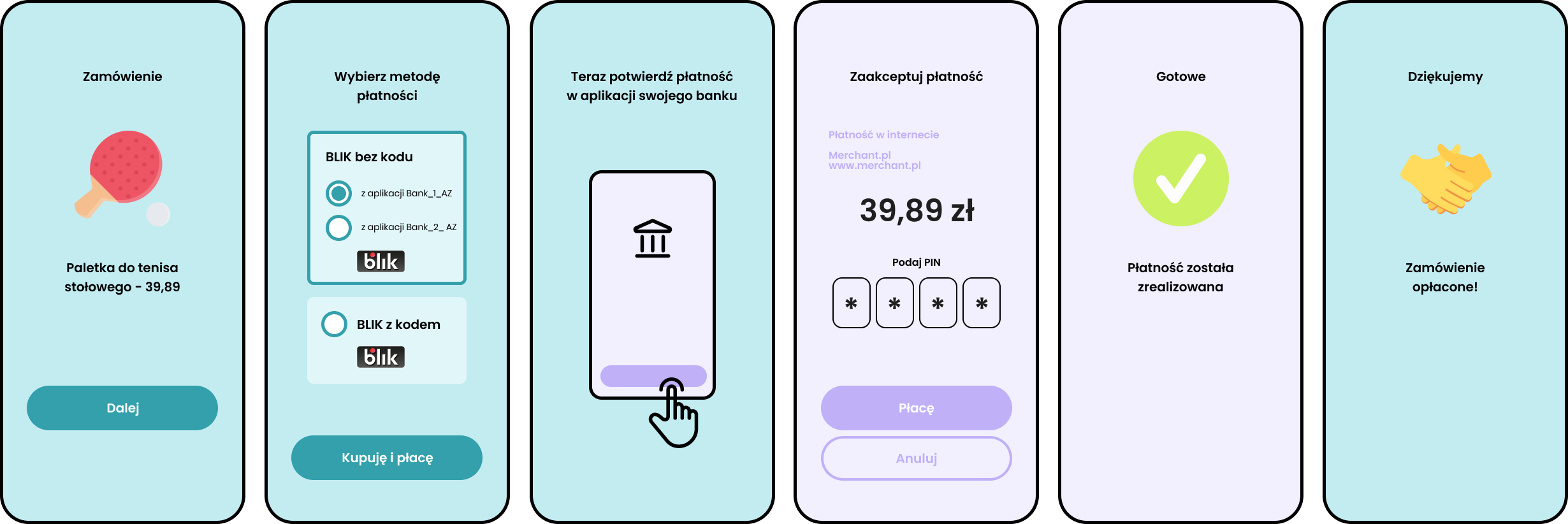
OneClick 2.0 – Automatic authorization for saved Shop
A customer who has already enabled OneClick payments (transactions that do not require a BLIK code) for a Shop can additionally enable the automatic authorization option so that transactions at that Shop don' t require confirmation in the bank's app.
Enabling this option is done by accepting the invitation to activate payment without confirmation in a saved Shop, which is presented in the bank's app after the customer has authorized a OneClick transaction. Such an invitation is presented only if the authorization request contains an automatic authorization flag.
In processTransaction recomendedAuthLevel = NOCONFREQ
If the customer has accepted the invitation, and the merchant initiating the next transaction has raised the automatic authorization flag, the bank will in most cases authorize the transaction without asking the customer to confirm it in the application (the flag is a recommendation to the bank, it does not impose automatic authorization).
For fraudulent transactions performed in automatic authorization mode, there is a liability shift to the Acquirer, (analogy to liability shift for card transactions performed without 3DS).
Currently, the automatic authorization option is implemented in the application of PKO Bank Polski (Poland's largest bank) and Allegro (Poland's largest eCommerce platform). The service has been very well received by customers. The share of such transactions is steadily growing. More banks and merchants have announced implementations in 2024.

